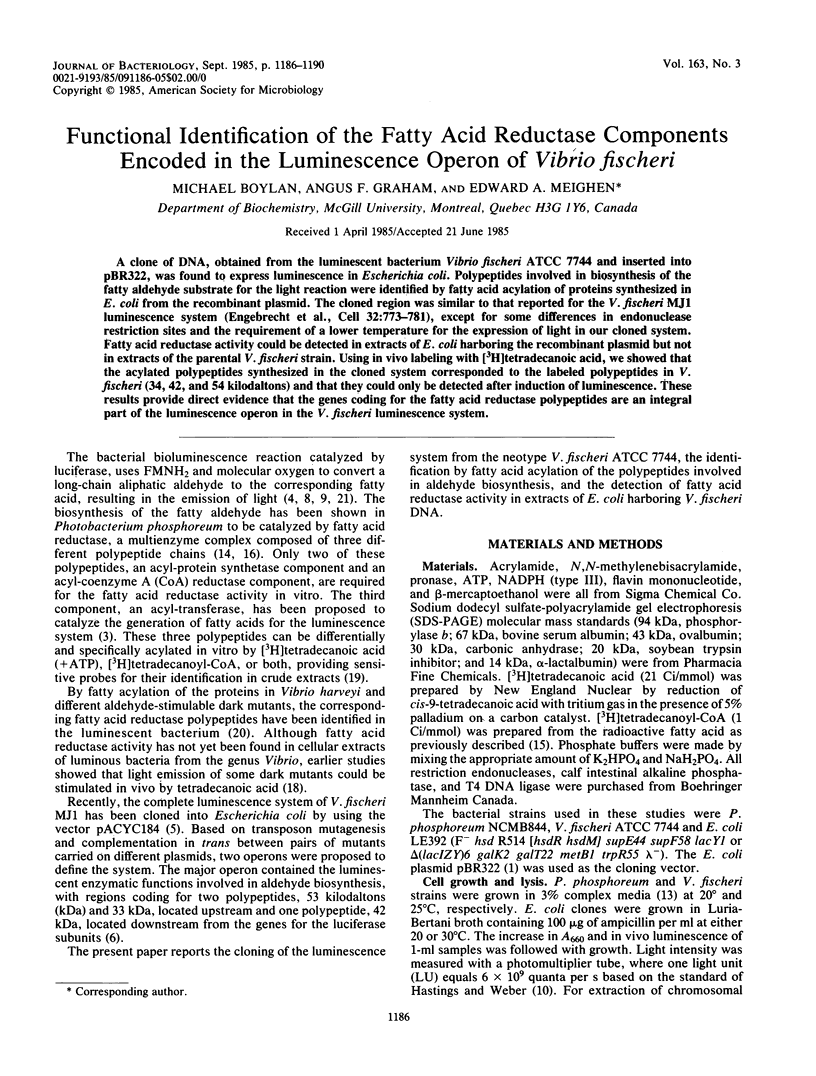Abstract
A clone of DNA, obtained from the luminescent bacterium Vibrio fischeri ATCC 7744 and inserted into pBR322, was found to express luminescence in Escherichia coli. Polypeptides involved in biosynthesis of the fatty aldehyde substrate for the light reaction were identified by fatty acid acylation of proteins synthesized in E. coli from the recombinant plasmid. The cloned region was similar to that reported for the V. fischeri MJ1 luminescence system (Engebrecht et al., Cell 32:773-781), except for some differences in endonuclease restriction sites and the requirement of a lower temperature for the expression of light in our cloned system. Fatty acid reductase activity could be detected in extracts of E. coli harboring the recombinant plasmid but not in extracts of the parental V. fischeri strain. Using in vivo labeling with [3H]tetradecanoic acid, we showed that the acylated polypeptides synthesized in the cloned system corresponded to the labeled polypeptides in V. fischeri (34, 42, and 54 kilodaltons) and that they could only be detected after induction of luminescence. These results provide direct evidence that the genes coding for the fatty acid reductase polypeptides are an integral part of the luminescence operon in the V. fischeri luminescence system.
Full text
PDF




Images in this article
Selected References
These references are in PubMed. This may not be the complete list of references from this article.
- Bolivar F., Rodriguez R. L., Greene P. J., Betlach M. C., Heyneker H. L., Boyer H. W., Crosa J. H., Falkow S. Construction and characterization of new cloning vehicles. II. A multipurpose cloning system. Gene. 1977;2(2):95–113. [PubMed] [Google Scholar]
- Bradford M. M. A rapid and sensitive method for the quantitation of microgram quantities of protein utilizing the principle of protein-dye binding. Anal Biochem. 1976 May 7;72:248–254. doi: 10.1006/abio.1976.9999. [DOI] [PubMed] [Google Scholar]
- Carey L. M., Rodriguez A., Meighen E. Generation of fatty acids by an acyl esterase in the bioluminescent system of Photobacterium phosphoreum. J Biol Chem. 1984 Aug 25;259(16):10216–10221. [PubMed] [Google Scholar]
- Dunn D. K., Michaliszyn G. A., Bogacki I. G., Meighen E. A. Conversion of aldehyde to acid in the bacterial bioluminescent reaction. Biochemistry. 1973 Nov 20;12(24):4911–4918. doi: 10.1021/bi00748a016. [DOI] [PubMed] [Google Scholar]
- Engebrecht J., Nealson K., Silverman M. Bacterial bioluminescence: isolation and genetic analysis of functions from Vibrio fischeri. Cell. 1983 Mar;32(3):773–781. doi: 10.1016/0092-8674(83)90063-6. [DOI] [PubMed] [Google Scholar]
- Engebrecht J., Silverman M. Identification of genes and gene products necessary for bacterial bioluminescence. Proc Natl Acad Sci U S A. 1984 Jul;81(13):4154–4158. doi: 10.1073/pnas.81.13.4154. [DOI] [PMC free article] [PubMed] [Google Scholar]
- Gunsalus-Miguel A., Meighen E. A., Nicoli M. Z., Nealson K. H., Hastings J. W. Purification and properties of bacterial luciferases. J Biol Chem. 1972 Jan 25;247(2):398–404. [PubMed] [Google Scholar]
- Hastings J. W., Nealson K. H. Bacterial bioluminescence. Annu Rev Microbiol. 1977;31:549–595. doi: 10.1146/annurev.mi.31.100177.003001. [DOI] [PubMed] [Google Scholar]
- Laemmli U. K. Cleavage of structural proteins during the assembly of the head of bacteriophage T4. Nature. 1970 Aug 15;227(5259):680–685. doi: 10.1038/227680a0. [DOI] [PubMed] [Google Scholar]
- Meighen E. A., Bartlet I. Complementation of subunits from different bacterial luciferases. Evidence for the role of the beta subunit in the bioluminescent mechanism. J Biol Chem. 1980 Dec 10;255(23):11181–11187. [PubMed] [Google Scholar]
- Meighen E. A. Biosynthesis of aliphatic aldehydes for the bacterial bioluminescent reaction: stimulation by ATP and NADPH. Biochem Biophys Res Commun. 1979 Apr 27;87(4):1080–1086. doi: 10.1016/s0006-291x(79)80018-2. [DOI] [PubMed] [Google Scholar]
- Riendeau D., Rodriguez A., Meighen E. Resolution of the fatty acid reductase from Photobacterium phosphoreum into acyl protein synthetase and acyl-CoA reductase activities. Evidence for an enzyme complex. J Biol Chem. 1982 Jun 25;257(12):6908–6915. [PubMed] [Google Scholar]
- Rodriguez A., Riendeau D., Meighen E. Purification of the acyl coenzyme A reductase component from a complex responsible for the reduction of fatty acids in bioluminescent bacteria. Properties and acyltransferase activity. J Biol Chem. 1983 Apr 25;258(8):5233–5237. [PubMed] [Google Scholar]
- SAITO H., MIURA K. I. PREPARATION OF TRANSFORMING DEOXYRIBONUCLEIC ACID BY PHENOL TREATMENT. Biochim Biophys Acta. 1963 Aug 20;72:619–629. [PubMed] [Google Scholar]
- Ulitzur S., Hastings J. W. Myristic acid stimulation of bacterial bioluminescence in "aldehyde" mutants. Proc Natl Acad Sci U S A. 1978 Jan;75(1):266–269. doi: 10.1073/pnas.75.1.266. [DOI] [PMC free article] [PubMed] [Google Scholar]
- Wall L. A., Byers D. M., Meighen E. A. In vivo and in vitro acylation of polypeptides in Vibrio harveyi: identification of proteins involved in aldehyde production for bioluminescence. J Bacteriol. 1984 Aug;159(2):720–724. doi: 10.1128/jb.159.2.720-724.1984. [DOI] [PMC free article] [PubMed] [Google Scholar]
- Wall L., Rodriquez A., Meighen E. Differential acylation in vitro with tetradecanoyl coenzyme A and tetradecanoic acid (+ATP) of three polypeptides shown to have induced synthesis in Photobacterium phosphoreum. J Biol Chem. 1984 Feb 10;259(3):1409–1414. [PubMed] [Google Scholar]




